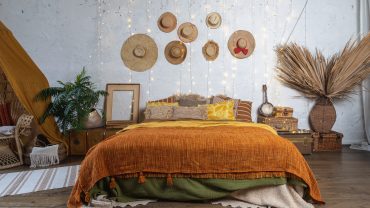From the scorching sands of the Sahara to the magical markets of Marrakech, the Moroccan house design style is celebrated for its enchanting fusion of colours, patterns, and textures, offering a stunning aesthetic that has captured the imaginations of designers and homeowners around the world.
Rooted in the country’s rich history, Moroccan interior decor blends the intricate artistry of the indigenous Berber tribes with Arabic, French, and Spanish influences, creating a visually beautiful and culturally significant interior décor theme.
Islamic influences are particularly notable, seen in the exquisite tile work and intricate geometric patterns that grace many Moroccan interiors. These elements are harmoniously combined with the bold colours and organic forms typical of Berber tribal designs, alongside European design elements introduced during colonial times. This melding of influences and design styles creates spaces that are historically rich while holding contemporary appeal.
So whether you’re decorating a second home by the seaside, or you want to add a touch of North African charm to a modern town centre apartment, Moroccan interior design may be just what you’re looking for.
A Short History of Moroccan Interior Design

Beautiful Moorish style tilework (Credit: Ilias Katsouras jr via Getty Images)
The Moroccan house design style intertwines the country’s indigenous cultural practices with external influences, developing into a distinctive, vibrant and dynamic look. The foundational elements can be traced back to the Moorish architectural style that emerged in the western Islamic world from the eighth century. Characterised by intricate arches, detailed mosaic tilework, and precise geometric motifs, this style profoundly shaped Moroccan interiors.
Additionally, due to Morocco’s strategic location, it absorbed influences from Spain, Italy, and France, as well as its North African neighbours of Tunisia, Algeria and Mauritania. These interactions introduced elements like indoor-outdoor living, the use of airy textiles, and an emphasis on lush plantings, further enriching the Moroccan design palette.
Over time, Moroccan interior design has evolved, reflecting both historical legacies and contemporary trends. The emergence of boho chic particularly influenced modern interpretations of Moroccan style, infusing it with a casual, eclectic vibe that emphasises comfort and artistic expression. This modern twist on traditional Moroccan interior decor continues to captivate and inspire, blending the old with the new in a celebration of Morocco’s rich cultural heritage.
The Key Principles of Moroccan Interiors

Classic Morrocan interior design (Credit: Westend61 via Getty Images)
Central to Moroccan interior design are the principles of comfort, hospitality, and abundance, which are expressed through the generous use of space, natural materials, handmade elements, luxurious textures, and warm, inviting colours.
Natural Materials
Moroccan interiors typically use natural materials that are locally sourced. Key materials include terracotta for tiles, cedar and walnut wood for intricate carvings, and wrought iron and copper for decorative grilles and lamp fixtures. These materials are celebrated not only for their earthy beauty but also for their durability and traditional appeal.
Colour Palette
The Moroccan colour palette is deeply influenced by the landscape, featuring the blues, reds and oranges of the sea and sky; beiges, taupes and whites of the desert sands, and the vibrant greens of the oases. These are complemented by deep purples, rich gold, brass and silver used in decorative accents, creating a warm and inviting atmosphere typical of Moroccan interior decor.
Comfort & Functionality
Comfort and functionality are cornerstones of Moroccan interior design. The layout often features low seating areas with plush cushions, encouraging relaxation and social interaction. Spaces are designed to be multifunctional, with decorative elements serving practical purposes, such as ceramic tiles that help regulate indoor temperatures.
Design Motifs, Handmade Elements & Textiles
Moroccan design motifs typically include intricate geometric patterns and lattices, floral designs, and Arabesque calligraphy, reflecting the style’s Islamic influences. Handmade elements are prevalent, with artisans employing centuries-old techniques to make pottery, metalwork, and embroidered textiles such as woven kilim rugs. Tassels, piping and contrasting buttons are often used to create a dramatic sense of glamour to Moroccan interiors.
The Great Outdoors
The traditional Moroccan house design style blurs the lines between indoor and outdoor living spaces, reflecting a lifestyle that embraces nature. Central courtyards, lush gardens, and ornate fountains are common, promoting a tranquil environment that is both practical in a hot climate and aesthetically pleasing.
Furniture
Furniture in Moroccan interiors often includes hand-carved wooden pieces, detailed mosaic tables, and luxuriously upholstered ottomans. Materials like leather and brass are also popular for their texture and sheen. The furniture is typically low-slung and modular, accommodating the social and familial aspects of Moroccan culture.
The Epitome of Elegance

Moroccan interior design (Credit: narvikk via Getty Images)
Elegance in Moroccan interior design comes from the joyous blend of luxury and craftsmanship. The use of ornate lanterns, silk drapes, and velvet throws adds a touch of sophistication, while the detailed craftsmanship seen in every element from door frames to furniture and exquisitely hand painted tiles speaks of a refined aesthetic that values artistry and detail.
The Lasting Charm of Moroccan Interiors

Ornate Moroccan bedroom design (Credit: Andreas von Einsiedel via Getty Images)
What is Moroccan interior design? In essence, it’s a celebration of the country’s rich cultural tapestry, skillfully intertwining traditional elements with contemporary influences to create vibrant, welcoming spaces.
Incorporating intricate design motifs, lush outdoor living areas, and elegant, versatile furniture, Moroccan interiors offer an aesthetic that’s both timeless and adaptable, capable of bringing a touch of Moroccan magic to your home.












